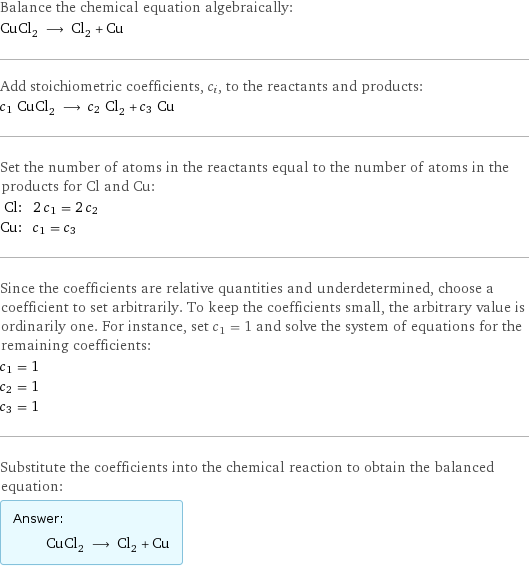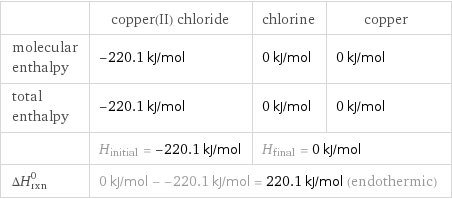Input interpretation

CuCl_2 copper(II) chloride ⟶ Cl_2 chlorine + Cu copper
Balanced equation

Balance the chemical equation algebraically: CuCl_2 ⟶ Cl_2 + Cu Add stoichiometric coefficients, c_i, to the reactants and products: c_1 CuCl_2 ⟶ c_2 Cl_2 + c_3 Cu Set the number of atoms in the reactants equal to the number of atoms in the products for Cl and Cu: Cl: | 2 c_1 = 2 c_2 Cu: | c_1 = c_3 Since the coefficients are relative quantities and underdetermined, choose a coefficient to set arbitrarily. To keep the coefficients small, the arbitrary value is ordinarily one. For instance, set c_1 = 1 and solve the system of equations for the remaining coefficients: c_1 = 1 c_2 = 1 c_3 = 1 Substitute the coefficients into the chemical reaction to obtain the balanced equation: Answer: | | CuCl_2 ⟶ Cl_2 + Cu
Structures

⟶ +
Names

copper(II) chloride ⟶ chlorine + copper
Reaction thermodynamics
Enthalpy

| copper(II) chloride | chlorine | copper molecular enthalpy | -220.1 kJ/mol | 0 kJ/mol | 0 kJ/mol total enthalpy | -220.1 kJ/mol | 0 kJ/mol | 0 kJ/mol | H_initial = -220.1 kJ/mol | H_final = 0 kJ/mol | ΔH_rxn^0 | 0 kJ/mol - -220.1 kJ/mol = 220.1 kJ/mol (endothermic) | |
Equilibrium constant
![Construct the equilibrium constant, K, expression for: CuCl_2 ⟶ Cl_2 + Cu Plan: • Balance the chemical equation. • Determine the stoichiometric numbers. • Assemble the activity expression for each chemical species. • Use the activity expressions to build the equilibrium constant expression. Write the balanced chemical equation: CuCl_2 ⟶ Cl_2 + Cu Assign stoichiometric numbers, ν_i, using the stoichiometric coefficients, c_i, from the balanced chemical equation in the following manner: ν_i = -c_i for reactants and ν_i = c_i for products: chemical species | c_i | ν_i CuCl_2 | 1 | -1 Cl_2 | 1 | 1 Cu | 1 | 1 Assemble the activity expressions accounting for the state of matter and ν_i: chemical species | c_i | ν_i | activity expression CuCl_2 | 1 | -1 | ([CuCl2])^(-1) Cl_2 | 1 | 1 | [Cl2] Cu | 1 | 1 | [Cu] The equilibrium constant symbol in the concentration basis is: K_c Mulitply the activity expressions to arrive at the K_c expression: Answer: | | K_c = ([CuCl2])^(-1) [Cl2] [Cu] = ([Cl2] [Cu])/([CuCl2])](../image_source/c3a5964328949f77417b0ac9b542f929.png)
Construct the equilibrium constant, K, expression for: CuCl_2 ⟶ Cl_2 + Cu Plan: • Balance the chemical equation. • Determine the stoichiometric numbers. • Assemble the activity expression for each chemical species. • Use the activity expressions to build the equilibrium constant expression. Write the balanced chemical equation: CuCl_2 ⟶ Cl_2 + Cu Assign stoichiometric numbers, ν_i, using the stoichiometric coefficients, c_i, from the balanced chemical equation in the following manner: ν_i = -c_i for reactants and ν_i = c_i for products: chemical species | c_i | ν_i CuCl_2 | 1 | -1 Cl_2 | 1 | 1 Cu | 1 | 1 Assemble the activity expressions accounting for the state of matter and ν_i: chemical species | c_i | ν_i | activity expression CuCl_2 | 1 | -1 | ([CuCl2])^(-1) Cl_2 | 1 | 1 | [Cl2] Cu | 1 | 1 | [Cu] The equilibrium constant symbol in the concentration basis is: K_c Mulitply the activity expressions to arrive at the K_c expression: Answer: | | K_c = ([CuCl2])^(-1) [Cl2] [Cu] = ([Cl2] [Cu])/([CuCl2])
Rate of reaction
![Construct the rate of reaction expression for: CuCl_2 ⟶ Cl_2 + Cu Plan: • Balance the chemical equation. • Determine the stoichiometric numbers. • Assemble the rate term for each chemical species. • Write the rate of reaction expression. Write the balanced chemical equation: CuCl_2 ⟶ Cl_2 + Cu Assign stoichiometric numbers, ν_i, using the stoichiometric coefficients, c_i, from the balanced chemical equation in the following manner: ν_i = -c_i for reactants and ν_i = c_i for products: chemical species | c_i | ν_i CuCl_2 | 1 | -1 Cl_2 | 1 | 1 Cu | 1 | 1 The rate term for each chemical species, B_i, is 1/ν_i(Δ[B_i])/(Δt) where [B_i] is the amount concentration and t is time: chemical species | c_i | ν_i | rate term CuCl_2 | 1 | -1 | -(Δ[CuCl2])/(Δt) Cl_2 | 1 | 1 | (Δ[Cl2])/(Δt) Cu | 1 | 1 | (Δ[Cu])/(Δt) (for infinitesimal rate of change, replace Δ with d) Set the rate terms equal to each other to arrive at the rate expression: Answer: | | rate = -(Δ[CuCl2])/(Δt) = (Δ[Cl2])/(Δt) = (Δ[Cu])/(Δt) (assuming constant volume and no accumulation of intermediates or side products)](../image_source/f7a07aa4b39a01cae9c5015923180d11.png)
Construct the rate of reaction expression for: CuCl_2 ⟶ Cl_2 + Cu Plan: • Balance the chemical equation. • Determine the stoichiometric numbers. • Assemble the rate term for each chemical species. • Write the rate of reaction expression. Write the balanced chemical equation: CuCl_2 ⟶ Cl_2 + Cu Assign stoichiometric numbers, ν_i, using the stoichiometric coefficients, c_i, from the balanced chemical equation in the following manner: ν_i = -c_i for reactants and ν_i = c_i for products: chemical species | c_i | ν_i CuCl_2 | 1 | -1 Cl_2 | 1 | 1 Cu | 1 | 1 The rate term for each chemical species, B_i, is 1/ν_i(Δ[B_i])/(Δt) where [B_i] is the amount concentration and t is time: chemical species | c_i | ν_i | rate term CuCl_2 | 1 | -1 | -(Δ[CuCl2])/(Δt) Cl_2 | 1 | 1 | (Δ[Cl2])/(Δt) Cu | 1 | 1 | (Δ[Cu])/(Δt) (for infinitesimal rate of change, replace Δ with d) Set the rate terms equal to each other to arrive at the rate expression: Answer: | | rate = -(Δ[CuCl2])/(Δt) = (Δ[Cl2])/(Δt) = (Δ[Cu])/(Δt) (assuming constant volume and no accumulation of intermediates or side products)
Chemical names and formulas

| copper(II) chloride | chlorine | copper formula | CuCl_2 | Cl_2 | Cu Hill formula | Cl_2Cu | Cl_2 | Cu name | copper(II) chloride | chlorine | copper IUPAC name | dichlorocopper | molecular chlorine | copper
Substance properties

| copper(II) chloride | chlorine | copper molar mass | 134.4 g/mol | 70.9 g/mol | 63.546 g/mol phase | solid (at STP) | gas (at STP) | solid (at STP) melting point | 620 °C | -101 °C | 1083 °C boiling point | | -34 °C | 2567 °C density | 3.386 g/cm^3 | 0.003214 g/cm^3 (at 0 °C) | 8.96 g/cm^3 solubility in water | | | insoluble odor | | | odorless
Units
